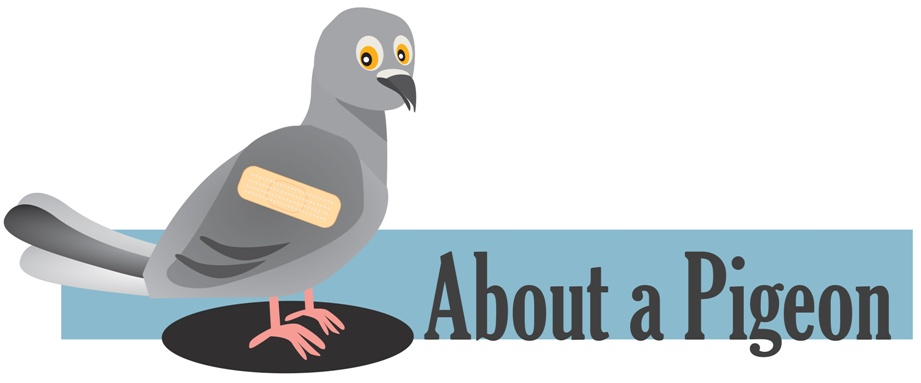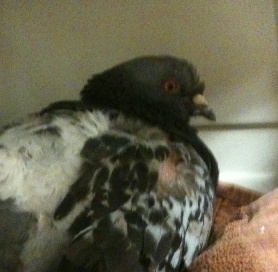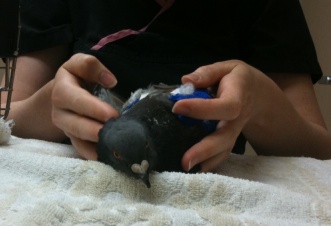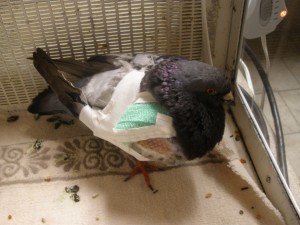
He was just a flash of white in the gutter as we drove quickly by—a brief impression seen from the corner of our eyes that somehow didn’t seem right. Was that a pigeon? Better double back and check. It happens to us a lot—seeing phantom injured animals along the road side that require a closer look. Most of the time, thankfully, the phantom turns out to be nothing—a shoe, or a crumpled bit of paper or a piece of garbage—and we can go back about our business, grateful and relieved to know there is nothing more to worry about. But sometimes, sadly, it is an animal, and an animal that is still alive. Over the years, we’ve rescued injured cats, a squirrel, crows, a cormorant, lots of pigeons, and twice, dead mother opossums with live babies in their pouches. This was to be one of those times. As we drove slowly by, that flash of white was no longer there—a bad sign. So we pulled over and began a search. That is when we found the pigeon—the little flyer we would come to name Commander Seymour Higgins—huddled behind the back wheel of a large, parked truck, a wing hanging low and limp by his side.
After stopping into a few businesses to get the necessary equipment—a box and an old blanket, we caught him. He was tired and weak so it was easy to do so: after chasing him out from under the truck, we cornered him in a doorway, and gently covered him with the blanket. Relief! Now we could get him to a wildlife rehabilitation facility where they would patch him up, give him several weeks of TLC, and release him back to his home, his flock, his life. As it so happens, pigeons—like wolves, swans, and some humans—mate for life. If there was a Mrs. Higgins, she would be worried for him, but she would wait.
 At least, that is the scenario we thought would happen. That is what we have naively thought had been happening all along, all these years, with all the injured or orphaned animals we’ve delivered to local wildlife rehab facilities. We now fear that in so many of those cases, we were wrong, with deadly consequences.
At least, that is the scenario we thought would happen. That is what we have naively thought had been happening all along, all these years, with all the injured or orphaned animals we’ve delivered to local wildlife rehab facilities. We now fear that in so many of those cases, we were wrong, with deadly consequences.
Shortly after delivering the pigeon to a local veterinary office that does wildlife rehab, we called to see if they had determined the extent of his injury. The vet we spoke to told us that the Commander had a fractured humerus—equivalent to the bone that runs from the shoulder to our elbow in our own arms. She explained that fixing it required surgery, and that were the pigeon a rare or endangered bird, they would do it. But given that he was a pigeon, making that sort of investment wouldn’t, according to her, make sense. And since he may never be able to fly again, she told us that the only humane thing to do was to kill him. We were stunned.
This bird did not have a life-threatening injury; he had a fractured bone. If they killed him, it wouldn’t be for his benefit, it would be out of convenience. According to her, since he was born the wrong species—a pigeon instead of a peregrine falcon—his wing wasn’t worth fixing, even though this particular hospital raises thousands of dollars from animal lovers in our community every year for wildlife rehabilitation. When we protested, she took out what she must have considered the “big gun.” She explained that the pigeon was “non-native” and had we taken him anywhere else—the Lindsay Museum, for example, treatment wouldn’t have even been considered—that they would have killed him immediately because of his species. If this was supposed to convince us, she couldn’t have picked a less compelling argument. Knowing that the Lindsay Museum schools their visitors, including hundreds of school children every year—to divide animals into two camps: “native” and therefore worthy of life and compassion on the one hand, and, on the other, “non-native,” foreign and therefore deserving of death, we have never, and would never, trust an innocent animal to their muddled and corrupted calculations, especially when lives are at stake. To therefore expect us to weigh the pigeon’s circumstances based on what the Lindsay Museum would do was unconvincing, to say the least.
Whether the Commander was a pigeon or a bald eagle should have made no difference to the vet. Her duty to him should have been dictated by his injuries alone—what he needed—as opposed to discriminatory determinations about his species. Unrelated and arbitrary calculations of his inherent “value” based on a narrow scope of compassion or worth dictated by others should not have entered the equation. Because although it is tragically commonplace for so-called “environmentalists” to weigh an individual animal’s value by their species, or when and where a particular animal’s ancestors originated, that doesn’t make it right to do so. In the same way we have rejected such discrimination of our fellow humans, recognizing that to judge the worth of an individual person by their ethnicity or where their parents originated is both unfair and immoral, we should strive to regard, and respect, the individual rights of animals in the same way.
Thankfully, as the shrill voices championing this disturbing philosophy have become louder, their language more militant, and the means they embrace to achieve their ends more violent and destructive, the common sense voices rejecting nativism are finally beginning to push back. And with more and more people beginning to speak out against this flawed and cruel philosophy, the movement against it will no doubt continue to grow and gain traction, so that within her lifetime, the veterinarian who prescribed death for our friend will be forced to re-examine her values.
 When it became clear that this vet would not treat the pigeon as part of her practice’s wildlife rehabilitation program and we asked to have the bird back so we he could live with us, we hit a wall of dogma so thick, we were seeing stars. In conversations with the doctor, her vet tech, and later, the emergency on-call “expert” at another wildlife rehabilitation facility called WildCare, when we explained that we planned to provide the injured bird a permanent place in our home if he could never fly again, we were treated like naïve, ill-informed and even selfish individuals for suggesting that the pigeon wouldn’t, in fact, be better off dead. “Of course it is admirable that you don’t want the pigeon to die,” said one of them, “But you can’t let your needs cloud your judgment. You need to consider what the bird would want. You need to consider what is in the bird’s best interest, not yours.” Again, we were stunned. After offering to pay to have the wing repaired, after explaining to them that we would be willing to provide the bird with a lifetime of care in our own home, at our own expense, and at to the very best of our ability, we were befuddled as to how we were being “selfish” or self-centered. Weren’t these actions the very definition of altruism?
When it became clear that this vet would not treat the pigeon as part of her practice’s wildlife rehabilitation program and we asked to have the bird back so we he could live with us, we hit a wall of dogma so thick, we were seeing stars. In conversations with the doctor, her vet tech, and later, the emergency on-call “expert” at another wildlife rehabilitation facility called WildCare, when we explained that we planned to provide the injured bird a permanent place in our home if he could never fly again, we were treated like naïve, ill-informed and even selfish individuals for suggesting that the pigeon wouldn’t, in fact, be better off dead. “Of course it is admirable that you don’t want the pigeon to die,” said one of them, “But you can’t let your needs cloud your judgment. You need to consider what the bird would want. You need to consider what is in the bird’s best interest, not yours.” Again, we were stunned. After offering to pay to have the wing repaired, after explaining to them that we would be willing to provide the bird with a lifetime of care in our own home, at our own expense, and at to the very best of our ability, we were befuddled as to how we were being “selfish” or self-centered. Weren’t these actions the very definition of altruism?
But we were soon to learn that in the topsy-turvy world of wildlife rescue, just as it has been until very recently in the animal sheltering world, up is down, and down is up. And death isn’t the ultimate tragedy; it is the suggestion that it is that is the problem. And, just as the directors of kill shelters have historically done—these wildlife rehabilitators were likewise willing to apply a mighty thick gloss of unsubstantiated, even entirely fabricated, dogma to prove that they were right. Among other disturbing assertions, including the bizarre claim by the “expert” at WildCare that if you could ask them, the majority of birds now alive in sanctuaries would rather be dead, we were given a host of conflicting and misleading information—all designed to shut us up and get us to tow the party line that killing our friend would be an act of kindness, even though he had but one broken bone.
We were twice given medical prognoses regarding his wing that were false. We were told by two of the “experts” that surgical repair of the wing would be difficult, risky surgery, although the avian specialist who later did the surgery assured us that this was not true. Either these experts were ill-informed and therefore ill-equipped to be making life and death decisions regarding the disposition of injured animals, or they lied to us that the surgery was “extreme” in order to quell and diminish our expectations, and therefore our demands.
Our conversations with these people revealed that, as in the world of animal sheltering, killing had become the default. Custom, convenience and a biological xenophobia against certain species of animals had reconciled them to the atrocity of killing healthy animals it was within their power to help. Killing had become the easy, and in their minds, even the “humane” thing to do, so much so that any suggestion to the contrary was considered cruel.
 And so we did what we had to do—we bit our tongues and silenced our criticisms long enough to get the pigeon out of danger. We smiled and bailed him out of the vet who refused to provide him any care other than a complimentary killing unless we paid for it, ultimately spending several hundred dollars for an x-ray, pain medication, and a wing wrap until we could get him to another vet.
And so we did what we had to do—we bit our tongues and silenced our criticisms long enough to get the pigeon out of danger. We smiled and bailed him out of the vet who refused to provide him any care other than a complimentary killing unless we paid for it, ultimately spending several hundred dollars for an x-ray, pain medication, and a wing wrap until we could get him to another vet.
At one point during the exam with the new vet, we asked if she thought he was in pain. “We can’t say for sure,” she answered. “But we can assume he is. After all, their biology is similar to ours. And we can therefore assume that what would cause us pain, would cause them pain, too.” Good advice, we thought, but wondered how when it came to the matter of life and death—the most grave and weighty decision of them all—this compelling similarity broke down for wildlife rehabilitators.
In spite of hardship, in spite of enormous obstacles, animals—human and non-humans alike—cling to life. The will to live is the most basic instinct of every living creature. When we found the Commander, he was desperately pecking at a tiny, hardened scrap of food smashed into the gutter, and when he was placed in reach of food and water, he ate and drank voraciously. He hadn’t given up. Who are we to give up on him or to make that decision for him? Especially when such a decision defies logic and our own experience as living beings?
How can anyone rationally assert that a bird who could never fly again would chose annihilation over a what may in the end be a less than perfect life, but life none-the-less? And how can anyone rationally justify the belief that an injured bird, if given the choice, wouldn’t make the same calculation, based on their instinctual will to live, made by millions of humans who can longer walk and are confined to wheelchairs—to go on living? They can’t. To argue that the Commander—or any injured bird not suffering a mortal wound—would ever choose death over life is dishonest.
Given the outpouring of support Commander Seymour Higgins has received on Nathan’s Facebook page, and the incredible generosity shown by people who are helping us pay for his care, we know there is a lot of untapped love and potential out there that wildlife rehabbers could be harnessing but are not, choosing instead to parrot the fiction that the only option—and the humane one—for pigeons like the Commander is a quick but unnecessary death at their hands, instead of what the situation really demands: a repaired wing, and, if need be, permanent placement in a sanctuary or a loving, new home which many people would no doubt be willing to provide, if only given the opportunity to do so.
As long as there is a mentality within the wildlife rehabilitation community* that some animals are more deserving of compassion and care than others, that killing healthy animals is a mercy, and that sanctuary care or adoption is not a viable option for injured animals that cannot be safely returned to the wild, then alternative, life-affirming outcomes for birds like Seymour will never be explored and developed. Killing will continue to be the default, because they have convinced themselves that there is no other option, when, in fact, there are. As Nathan writes in Redemption, “If you deny any responsibility for the outcome, then the impetus to change your own behavior that might impact that outcome disappears.”
Life. That is what we would choose for ourselves. And despite all of the rationalizations built up to justify convenience killing by some wildlife rehabilitators—that is what every single animal would choose for themselves if given the choice. We must begin to publicly challenge the unethical assumptions upon which life and death calculations for so many injured wild animals are being based, or nothing will change; animals who could be saved will keep being killed, the public will continue to be misled by self-proclaimed “experts” that killing animals who are not mortally ill or injured is the right thing to do, and well-intended animal lovers like us who think they are giving the injured animals they find a second chance at a wildlife rehabilitation facility will continue to naively and unknowingly deliver birds like Seymour out of one danger and into an even graver one.
————
* We recognize that there are wildlife rehabbers who do not share this mentality and we are grateful for their support and guidance with Commander Higgins. To us, they are like the No Kill shelters and rescue groups who provide a beacon of hope in a movement dominated by the darkness of killing shelters.